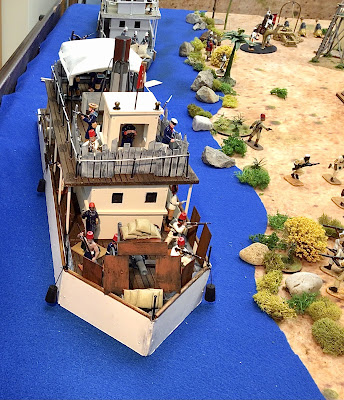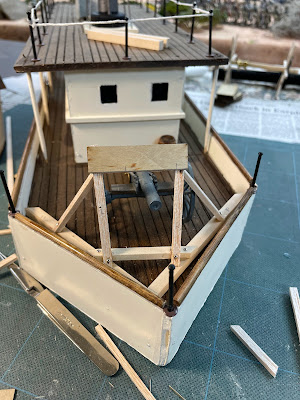Hope that you have a spooktacular evening.
Monday, October 31, 2022
Friday, October 28, 2022
Nile River Table Top Battle
 |
| Nile River gunboats attempt to run the Dervish blockade. |
CLICK ON ALL PICTURES TO SEE THEM IN THEIR FULL SPLENDOR
Every so often I clear all of the terrain off of my wargame table and set up new terrain, or more accurately, a new diorama. I had the desert terrain on the table for a couple of months and I decided that it was time for something new. Since I'm in the midst of constructing 54mm boats for my Khartoum Project, I thought that a stretch of the Nile River would look nice.
I already finished a paddle wheel steamer for the British/Egyptians and a dhow for the Dervish, but then I decided "in for a penny, in for a pound" and opted to make another steamer and three more dhows. This will give me a good sized flotilla of boats with which to play a Limeys & Slimeys in the Sudan type of naval game.
One of the advantages of laying out your terrain ahead of a battle is that you get a better idea of the table spacing as well as it revealing some of the terrain items that you could/need to enhance the overall look of the scenery. I will likely leave all of this river terrain up on the game table for at least the whole month of November or as long as it takes me to complete the build of the other boats that I intend to build. The terrain provides the inspiration to work on the new boats.
After I set up the river terrain that is shown in the pictures below, I started taking photos but found that the cluttered background made it difficult to get a good picture. So I bought 8 yards of sky blue felt cloth and suspended it from the ceiling tiles to give me a sky photo background. I then took a can of white primer and sprayed some random cloud patterns. I would recommend doing the spray painting outdoors. I didn't follow my own advise I am sad to say.
I ordered some dark blue felt (5 yards) to use as the Nile River water. I folded the six feet wide cloth into three feet width and placed it down the middle of the table. I wanted to keep my Cigar Box Battle Mats desert terrain visible as the shoreline on both sides of the river. My table is currently set up for 12 feet in length, but I have enough felt and Cigar Box mats to extend the river out to 20 feet for a convention game. Hopefully I will get enough players in this game if I run it at Historicon 2023.
I have to say that I think this is one of the best table top set ups that I have ever done. One obvious thing that I spotted was the need to make some riverbank pieces to lay along the sides where the felt meets the game mat. I had previously made some dry wadi sections (12" by 5") and so I placed these alongside the river to give me an idea of what some similar riverbank pieces might look like.
I could also lay pieces of clear shower curtain on top of the felt to get a reflection on the water.
 |
| Britain's Nile River boat (left) and my scratch built boat (right). |
 |
| Note the placement of the wadi modules on the riverbank on the right. My proposed riverbank sections would be curvy and irregular looking. |
 |
| A Dervish dhow contests the river passage with a smaller British boat. |
 |
| Trophy of Wales made the smaller screw-driven Nile River boat. |
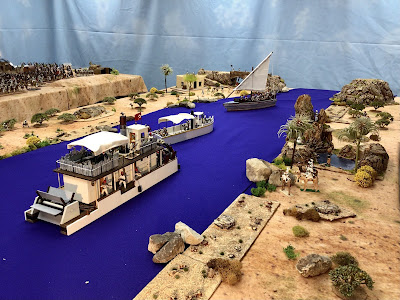 |
| A view of an oasis on the right bank of the river. |
 |
| Some curious Dervish watch the infidels' boats pass them by. |
 |
| Nile River boat made by Britain's for the collectors market. |
 |
| A Dervish held village along the Nile. |
 |
| A great overhead view of the table top. |
Last night, after setting everything up, I stayed up way too late just admiring my handy work and I'm now paying the price of insufficient sleep. I foresee an afternoon nap coming up.
Keep coming back for updates as I build the planned boats. They shouldn't take too long to build.
Tuesday, October 25, 2022
Tutorial: The Great Dhow Project Begins!
 |
| A typical Dhow boat used throughout the Mediterranean, Middle East and India areas of the world. (I didn't make this model) |
It was inevitable that once I built one boat that I would want to build some more. I decided to build a Arabic river dhow for two reasons: (1) I already had an available hull and (2) the Dervish needed some boats too. Actually, maybe there is a third reason: I foresee some sort of "Limeys & Slimeys On The Nile" type of game in my future. Oh, and a fourth reason is that dhows are relatively easy to build compared to a paddle wheel boat. More on that later.
So I was kind of in between projects in my overall Khartoum Project for Historicon 2023 and I was looking for something to do, one that did not involve a lot of preparation work. I remembered that I had a boat hull sitting around that I intended to convert into a dhow one day. Well Pilgrim, today is that day.
The shabby looking, weathered and beat up boat was an item that I bought at Hobby Lobby two or three years ago. It's one of those things that you see in a store or flea market and think "I could use that for something one day." When you see these things you must buy them right there on the spot because if you hesitate and walk away, you will surely change your mind and then the item will not be available when you decide that you want to buy it after all.
You can see a close up of the hull in the picture below:
FYI, I found the boat in Hobby Lobby's "Home Decor" section of the store. If you can't find one at the store, they are also available online through HL's web site. They are currently on sale at only $9.99 each which is quite a bargain.
I really like the weathering that the model comes with. It is primarily white in color but also has some red and light blue bits on it. The weathering gives the hull a nice "beat up" appearance which I also like.
Here are some pictures of the finished model:
Constructing the deck
I built a floor base out of foam core board and cut it to fit snuggly inside the hull. Then I cut out a deck using 1/4-inch balsa wood. The balsa was scored with the sharp end of a shish kebob skewer to suggest deck planking. Then the balsa was stained with Minwax Walnut color stain.
In the process of cutting out the shape of the balsa wood deck, I placed the hull on top of a piece of 4-inch wide balsa wood and traced the outline of the boat onto the wood. Since I was cutting the wood in the direction of the wood grain, it was very easy to cut out the shape with a No.2 Exacto knife blade. I looked at the two off cut pieces of balsa and envisioned them as sidewalls on the deck of the boat.
The side walls were fitted to the inside dimensions of the deck and I cut out some shims to place between the two sides of the hull to hold the pieces in place. I ran a bead of Liquid Nails paste on the inside wall, placed the offcut on the wall, and inserted the shims to hold the curve of the wood in place. I also pressed the pieces together with my fingers and counted to 60. The glue join was good and would likely not come undone. However, just to make sure, I used some tacks and hammered them into the interior sides for more strength. I left the shims inside the boat overnight and removed them the next day.
Making a mast
The main mast was made from a piece of round dowel rod. I think that it was a 3/4-inch diameter rod. It looked ok for the mast, but was probably too big around for the yard arm, so I used a 5/16 diameter dowel rod for the long yard arm (is this the correct term? I don't know for certain). In the future, I will use the smaller 5/16ths diameter dowel rod for both pieces.
I drilled holes into the foam core board and the balsa wood deck to accommodate the mast, making sure not to make the hole too large because I want a snug fit of the dowel into the hole. I also placed a ring grommet underneath the deck, on the floor of the hull, to use as a guide for when the mast is inserted into the holes on the deck and foam core board. My original intent was for the mast to be removable, but I changed my mind about this later.
The yard arm for a lateen sail (the triangular sail on a dhow) appears to be approximately the same length as the hull of the boat and the mast looks to be about half the length of the yard arm. I couldn't find any information to confirm this, but this is what eye-balling it informed me.
The final bit of mast support was to make a 1.5-inch square piece of balsa that I glued to the deck (with an appropriately sized hole in the middle of the square) and then I placed a plastic bottle cap from a water bottle on top of the square balsa piece. The bottle cap has a hole drilled through it and then I coated it with black spray on primer. The sum of the snug hole in the deck, the grommet seating in the bottom, and the square balsa/round bottle cap on the deck create enough support so that the mast does not tip over once the sail and yard arm are attached.
Making the sail
This proved to be the most difficult part of the model to make. Again, I could not find anything online that would indicate the relative proportion of the sail to the mast etc. Some basic high school geometry probably solves the size of the sail problem. You already know the length of the yard arm (13" in my model) and you know the height of the mast, so you have two sides of a right triangle and so the geometry should yield the answer to the length of the sail. I was having some problems with the calculations, so I resorted to the not so great "eyeballing it" method. It all worked out ok in the end, but the maths took me longer than they should have.
Another thing to consider is the type of material that you will use for your sail. I used some natural color canvas that I bought at Michael's Stores or Hobby Lobby. However, when you cut the cloth, the cloth will eventually start to unravel unless you hem the edges. This would be easy peasy if you owned a sewing machine, but I don't have one so I had to resort to other methods. My method is to fold the edges of the cloth over by half an inch, staple the hem in place, and then add super glue to fix the hem. After the glue dries, the staples can be removed because the super glue has hardened and cured.
So I cut the sail one half inch larger on all three sides so that I can fold the edges over to hem the cloth. On the yard arm side of the sail, I made sure that I let enough space to thread the dowel rod through the sail.
Attaching the yard arm and sail to the mast
This was a bit of a challenge, attaching the yard arm to the mast. As you can see in the picture below (someone else's model, not mine) a lot of rope is used to attach the parts. This was not a level of detail that I wanted to get into. After all, this is supposed to be a simply model for war gaming purposes, not a work of nautical art.
I solved the problem of having to use rope cords to attach the sail to the mast, by pushing the dowel rod through the hem of the sail (sort of like on a curtain rod). Next, I hammered a small tack to the mast to use as a sort of coat hook on which to hang the sail. I cut a hole in the sail so that it could hook onto the tack on the mast. Next, I cut pieces of white cord to make rigging that ties down the fore and aft ends of the yard arm to the deck. Another short piece of rigging attached the third corner of the sail to the boat deck. I used small push pins (pushed into the hull) to provide a place to attach the rigging to the boat.
Now all three corners of the sail are tied down to the boat in some manner. This is why I gave up on the idea of having the mast removable. With all three corners of the mast secured, the sail is securely in place and nicely stretched out. We don't like to have droopy sails now, do we?
 |
| A professional model illustrates how the sails are connected to the mast and yard arms. |
 |
| Here's a view of my rigging system |
Well that is about it on how I made my dhow. I have three more hulls on order from Hobby Lobby and so hopefully I will have a larger Dervish fleet in another week or two. Dhows are so much easier to make than other types of boats. Once you have the mast and sail techniques nailed down, and you have a ready made hull from Hobby Lobby, then it doesn't take much time to replicate the technique over several more boats.
As I said earlier, it is inevitable that there will be a Sudan naval battle game. This could be one of the games that I run at Historicon 2023.
Oh, did I forget to mention that this whole Khartoum in 54mm Project will be seen at Historicon in July 2023? (Just making sure).
Friday, October 21, 2022
My Nile River Boat Is Finished
CLICK ON ALL PICTURES TO ENLARGE
Well I finished my first ever "build a boat" project today as I finished off the Nile River paddle boat with the assembly of the rear paddle wheel mechanism. I was saving the "hardest for last" element of the ship, but it turned out that the paddle wheel was not as hard as I thought that it would be.
This last sentence pretty much sums things up: building terrain in general and boats in particular turn out to be not as hard to do as expected.
I started the construction on October 4th and finished it today, October 20th.
The only thing left to do is to figure out a name for the boat. Any ideas? Leave them in the comment section at the bottom of this post.
The boat is armed with a Krupp artillery piece in the bow and a Gatling Gun in the stern. There is room in the middle to add another machine gun, if needed. (If needed!!!????)
 |
| Midsection: there is space to place a second Gatling Gun on the main deck. |
 |
| Krupp Gun and crew in the bow with boiler plate metal protection. |
 |
| Midship: room for another Gatling Gun if needed. |
What's next? There might be another paddle boat in the future, maybe a side wheeler, or some small dhows to be manned by the Dervish. There could be some potential river battles with boats.
Monday, October 17, 2022
Eight Hours of Life That I'll Never Recover
Following up on my previous post about progress on the Nile River paddle wheel boat, I decided that I will make removable protective plates for the bow and a removable canopy on the top deck. Thus on Saturday evening I went down into the Man Cave, turned on some Joe Walsh music (best guitarist, eval!), looked for some of those little used tools from high school geometry class (compass, protractor and right angle square) and set to work making the frame for the front plates of the boat.
I spent about four hours on Saturday and another four hours on Sunday to build just the frame for the bow plates. It is a lot more complicated than it looks, more like the roof trusses on Notre Dame Cathedral in Paris. Some of the angles killed off a few of my brain cells, particularly when working with the four upper struts.
Here are some pictures of the basic frame for the protective mantel for the bow of the boat.
The basic "V" shape of the base was easy enough to do as all that was required was to measure and follow the dimensions of the bow of the boat. The base was made out of basswood.
The two forward struts that attach to the base were made of balsa wood, knowing that it is easier to drill holes into balsa rather than bass wood. These were set at a 60-degree angle to the base and had the support of the cross piece on the base. I clipped off some sewing pins to make pins to help hold the parts together. The parts were glued together primarily with super glue, but I also used some white Tacky Glue in certain areas.
The two struts in the back were the brain killers because I could not use a conventional 45-degree or 60-degree angle to join the two pieces of wood. I used a 60-degree angle to attach the strut to the V part of the base, but the strut did not butt up flat against the forward struts. I had to cut a notch out of the forward struts and drill holes through the two pieces so that I could insert a pin to strengthen the join.
Anytime I had to drill into the balsa wood I was afraid that the drill might split the wood and then I'd have to start all over again. Fortunately there was no breakage, but it took another four hours on sunday to work out all of the angles and positions of the pins.
Then I started attaching the front plates (no pictures today) to the front of the frame and the sides, but for some reason it took forever to work out a snug fit for the plates. I hope to finish up this part of the job and get it painted by tomorrow.
I also began work on the paddle wheel, but it will be a few more days before I can finish it. I went to Hobby Lobby and found some decorative gears in the bead/necklace department, from which I made the basic shape of the wheel. Pieces of bass wood where glued to the gear to extend the spokes of the wheel. I used a 3/4 inch dowel rod as the axel. The picture below provides a mock up of how the paddle wheel might look when the project is finished.
 |
| Mock up of the paddle wheel shown in the picture above. |
It looks like the canopy will be the last item that I make on this model. The canopy shown in the picture is borrowed from another boat model and it is "for show" on my model.
All of these seemingly simple tasks take lots and lots of time.
Saturday, October 15, 2022
Nile River Boat in 1/32 scale - Almost finished.
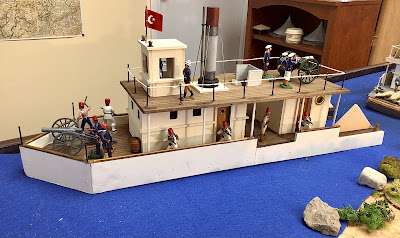 |
| River boat without canopy |
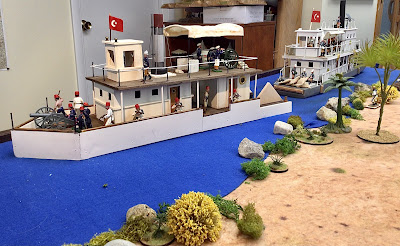 |
| River boat with canopy |
I have been very busy in the Olde Fritz Shipyard & Works this past week working on my Nile River paddle wheel boat for my Khartoum game. As of yesterday I have finished everything except the paddle wheels, which are a complicated piece of engineering, so I saved that part of the construction for last.
She's looking pretty good so far, but I have two minor considerations to make before actually "finishing" the boat. First of all, should I include a canvas canopy on the upper deck or go without the canopy? The two pictures above compare these two options. What do you think?
The second item is whether or not I should have some protective wood or boiler plate metal plates attached to the front of the boat to protect the artillery crew. Below are comparative pictures that indicate what the boat would look like with or without the plates. Which version looks better to you?
 |
| Wood plates (1" by 2") to simulate protective metal or wood plates. The final versions would be painted, so these are just "stand ins". |
The following picture shows some of the detail that I put on the smoke stack and also shows a close up of the safety railing on the second deck. The smoke stack is made from a piece of 3/4" diameter dowel. It is tricked out by the addition of four support poles leading from the base to the smoke stack. The vertical pipe on the side (is this a steam whistle?) is a small piece of dowel stick painted a metallic color. The two metallic bands on the stack are pieces of card board (cut from an index card). The black base at the bottom provides support for the dowel rod so that it doesn't move - this is made from a plastic water bottle cap. The white base is cut from some balsa wood.
 |
| I rather like the detail that I put on the smoke stack |
The railing around the perimeter of the upper deck has poles made from pop rivets that I've turned upside down so that the flange at the base is on the upward side. The railing cords are made from white string, which is unraveled slightly so that it fits over the pop rivet. I then put a drop of super glue so that the join of the string to the pop rivet is solid.
The little rectangular white wall provides protection so that someone doesn't fall down the hatch hole. I fashioned a ladder (from balsa wood and sewing pin rungs) the leads from the first deck to the upper deck. After all, the crew need some way to climb from the main deck to the upper deck.
A final bit of bling was to put a dark stained handrail on top of the side walls of the hull, which was made from foam core board. This provides a nice finishing touch to the model. I used wood stain, Walnut color, on the decks and the hand rail.
 |
| At the last minute, I added some dark stained hand rails around the edges of the hull. |
 |
| The new river boat in the foreground, compared to the old boat in the background. |
The red Egyptian flag was "borrowed" from another boat model to use in this photo shoot. I will eventually make my own flag out of paper and return the metal version to its rightful owner. The boat needs an anchor and I may have to do an on line search for 1/32 scale boat fittings unless I can find one at either Hobby Lobby or Michael's Stores.
Now I have to do some complicated engineering to make the paddle wheel at the rear of my boat. I will probably inspect the wheel on the original boat and see if I can copy its construction. I also have Diane Sutherland's (the Wargame Widow) book on terrain, Volume 2, which describes the steps that she takes to make a paddle wheel.
Once this project is completed, General Gordon's Nile River fleet will have two stern paddle wheel boats, one side wheel steamer, and two smaller screw driven boats. Then it might be on to making some dhows for the Dervish. Limeys & Slimeys on the Nile, anyone?
Please feel free to leave any comments or suggestions in the comments section below. I'd particularly like to hear some opinions on canopy or no canopy, and protection panels or no panels on the finished boat.
One final thought about this project; I thought that building a river boat was beyond my modeling skills, but as often is the case, it's a simple matter of rolling up your sleeves and giving it a try. It's easier that it looks.
By the way, all of the 54mm figures shown on the boat are Trophy of Wales miniatures.
Thursday, October 13, 2022
Battle of Fontenoy - Best of Show at Partizan This Year
 |
| Steve Ignatiev's splendid collection of the armies at Fontenoy. Photo by Steve |
My congratulations go out to Steve (nom de plume = Ignatiev) for his award winning game at last weekend's The Other Partizan convention in the UK. I believe that Steve won the Best Demo Game award for his rendition of the Battle of Fontenoy in 1745. Steve has amassed a beautiful collection of Minden and Crann Tara British, French, Hanoverians and Dutch infantry and cavalry.
 |
| I believe that these are Minden Prussians painted as Dutch soldiers by Mark Allen. The Dutch flags are made by War Flags. Steve did the basing of the figures. Photo by Steve |
You can find more photos of Steve's game and collection from the various Facebook groups devoted to 18th Century wargaming:
Wargaming in the Age of Frederick the Great
Seven Years War Wargaming
18th Century Wargaming
Warfare In The Age of Reason
It is really good to see that the War of Austrian Succession & Seven Years War games can garner attention in the UK. Hopefully such games will do better at future conventions in the United States. Steve put together a winning combination of great looking EVERYTHING (bespoke terrain, superbly painted figures that are attractively based, Minden and Crann Tara figures).
There were lots of good looking games at Partizan and I'd hate to have to be the person who had to choose "the best in show" games for awards. So a tip of the tricorn goes out to Steve for putting on a great looking game and showing off the best of 18th Century history and wargaming.
nnn
Sunday, October 9, 2022
Anyone Up For Some 54mm Pulp Adventures?
 |
| British expedition seeking the Tomb of Tut |
I have been eying the delightful offerings from King & Country and John Jenkins Designs in the area of King Tut Archeological and WW1 Desert Vehicles, respectively. These are 54mm to 60mm figures from Hong Kong and are aimed for the figure collectors' market, rather than that of war gamers. However, it doesn't prevent one from playing skirmish level games with the figures.
King & Country manufactures the Egyptian terrain in these pictures: King Tut tomb entrance, Sphinxes, stone blocks, and scaffolding. And most of the figures shown are from K&C. John Jenkins Designs makes the Rolls Royce armored car and the Ford Model T car (there are 4 different models to choose from)
 |
| Tomb raiders about to find out that there are dangers to their professions. |
Here are some close up photos of the two vehicles. I bought the Rolls Royce maybe four years ago. I had no gaming use for it at the time, but I really liked the look of it and so I bought it so that I could display it on one of my shelves. I saw the Model T Ford at the Chicago Toy Soldier Show this past September 2022 and I similarly made a mental note that I should buy one of these in the future. I didn't buy my copy at the show, but waited at home for about a week before hitting the Purchase Button.
 |
| Love at first sight: Rolls Royce armored car and Ford Model T car. |
 |
| The Mummy isn't happy that his sarcophagus is being carried away to the British Museum. |
Now it is time to start building a back story for American professor Colorado Smith and his faithful dog Bentley.
Other possible characters :
Captain Louis Reynaud
Professor Otto Schmidt and Karl Hans Alberti
That Pettygree fellow and his family
Lord Cavendish of the British Museum
Karl von Munchmuller of the Pergamum Museum
















